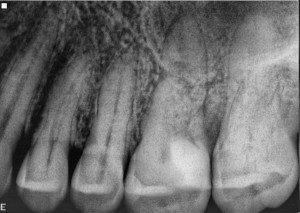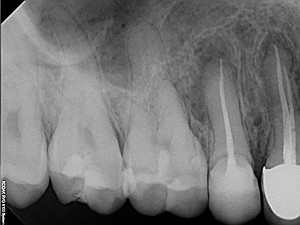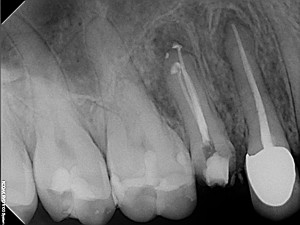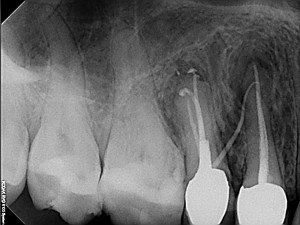Radiographic findings are never the whole story. Very often when I walk into the room, patients will ask me what I think of the radiograph. I usually try to move on to establish a diagnosis, but if forced, I will tell them the following:
“Xrays are like the evidence in a court case. The clinical history is like witness testimony and in the end my job is to decide, without bias, what needs to be done. The best way to make an accurate diagnosis, is to wait until you have all of the available evidence and testimony in front of you.”
The things we see on radiographs have to jibe with what we are seeing clinically, or with the history taken to move forward. Very often, as in the following cases, patients present with a sinus tract. Although it is often clear where the infection originates, I still believe in a thorough diagnosis before proceeding. This includes periodontal probings, vitality testing, and clinical history.
The use of a small gutta percha point inserted into the sinus tract followed by a radiograph or two can give us a great deal of information. In the case below, I was able to determine the origin of the infection. Although the clinical findings were in line with the radiographic findings and there were no other teeth in the quadrant that had restorations, if you can find a smoking gun, you are always better off.
For this patient in particular it was very important. Although she had a sinus tract apical to the gingival margin on #13, she was unconvinced that this condition was serious. In fact, after a brief review of the pathophysiology of the lesion in question, it was pretty clear that she remained unconvinced of the need for treatment. The radiograph below clearly illustrated that she had an infection in her jawbone that was open to her oral cavity. Her demeanor changed pretty dramatically after seeing the picture below:
In the final case, treatment was performed on tooth #4 two years earlier and the films are below. I was glad to see that upon radiographic evaluation, the tooth had healed, and that is was in fact tooth #5 that caused the lesion. The patient was surprised as well, as he was certain that the root canal on tooth #4 had failed when he recently phoned the office.
PreOp
PostOp
Recall
Trust but verify. Who could have imagined that it applies to endodontics as well as politics?
